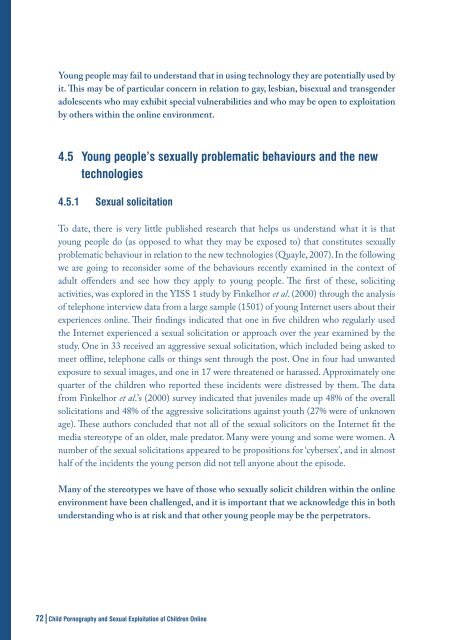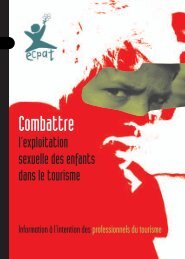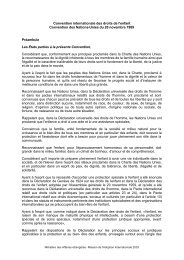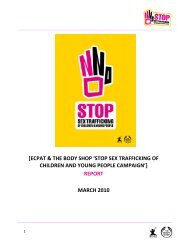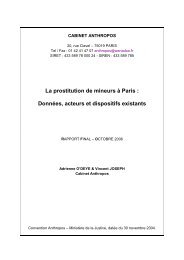child pornography and sexual exploitation of children online
child pornography and sexual exploitation of children online
child pornography and sexual exploitation of children online
Create successful ePaper yourself
Turn your PDF publications into a flip-book with our unique Google optimized e-Paper software.
Young people may fail to underst<strong>and</strong> that in using technology they are potentially used by<br />
it. This may be <strong>of</strong> particular concern in relation to gay, lesbian, bi<strong>sexual</strong> <strong>and</strong> transgender<br />
adolescents who may exhibit special vulnerabilities <strong>and</strong> who may be open to <strong>exploitation</strong><br />
by others within the <strong>online</strong> environment.<br />
4.5 Young people’s <strong>sexual</strong>ly problematic behaviours <strong>and</strong> the new<br />
technologies<br />
4.5.1 Sexual solicitation<br />
To date, there is very little published research that helps us underst<strong>and</strong> what it is that<br />
young people do (as opposed to what they may be exposed to) that constitutes <strong>sexual</strong>ly<br />
problematic behaviour in relation to the new technologies (Quayle, 2007). In the following<br />
we are going to reconsider some <strong>of</strong> the behaviours recently examined in the context <strong>of</strong><br />
adult <strong>of</strong>fenders <strong>and</strong> see how they apply to young people. The first <strong>of</strong> these, soliciting<br />
activities, was explored in the YISS 1 study by Finkelhor et al. (2000) through the analysis<br />
<strong>of</strong> telephone interview data from a large sample (1501) <strong>of</strong> young Internet users about their<br />
experiences <strong>online</strong>. Their findings indicated that one in five <strong>child</strong>ren who regularly used<br />
the Internet experienced a <strong>sexual</strong> solicitation or approach over the year examined by the<br />
study. One in 33 received an aggressive <strong>sexual</strong> solicitation, which included being asked to<br />
meet <strong>of</strong>fline, telephone calls or things sent through the post. One in four had unwanted<br />
exposure to <strong>sexual</strong> images, <strong>and</strong> one in 17 were threatened or harassed. Approximately one<br />
quarter <strong>of</strong> the <strong>child</strong>ren who reported these incidents were distressed by them. The data<br />
from Finkelhor et al.’s (2000) survey indicated that juveniles made up 48% <strong>of</strong> the overall<br />
solicitations <strong>and</strong> 48% <strong>of</strong> the aggressive solicitations against youth (27% were <strong>of</strong> unknown<br />
age). These authors concluded that not all <strong>of</strong> the <strong>sexual</strong> solicitors on the Internet fit the<br />
media stereotype <strong>of</strong> an older, male predator. Many were young <strong>and</strong> some were women. A<br />
number <strong>of</strong> the <strong>sexual</strong> solicitations appeared to be propositions for ‘cybersex’, <strong>and</strong> in almost<br />
half <strong>of</strong> the incidents the young person did not tell anyone about the episode.<br />
Many <strong>of</strong> the stereotypes we have <strong>of</strong> those who <strong>sexual</strong>ly solicit <strong>child</strong>ren within the <strong>online</strong><br />
environment have been challenged, <strong>and</strong> it is important that we acknowledge this in both<br />
underst<strong>and</strong>ing who is at risk <strong>and</strong> that other young people may be the perpetrators.<br />
72|Child Pornography <strong>and</strong> Sexual Exploitation <strong>of</strong> Children Online


